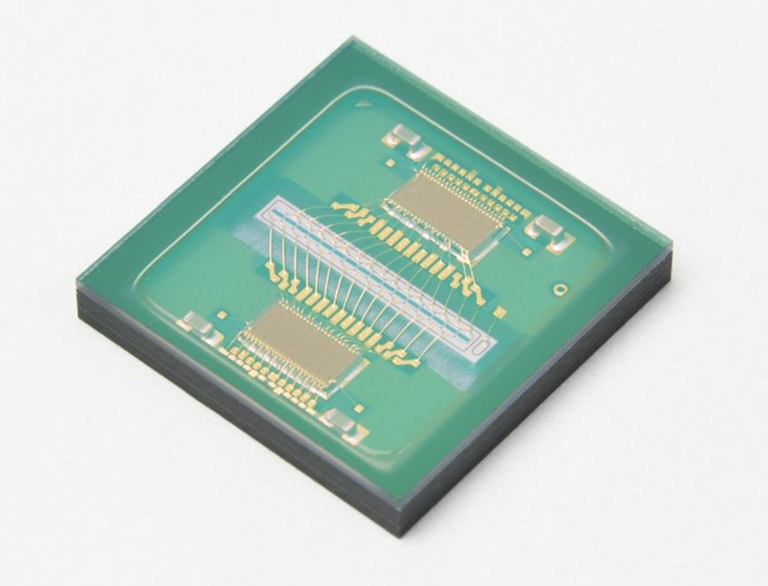October 12, 2022
Hamamatsu Photonics, have successfully developed an avalanche photodiode (APD) array called the "Gain Stabilized Si APD S16430-01CR" for industrial LiDAR(*1) use. This APD array was integrated with a self-bias generator (SBG)(*2) by harnessing their unique advanced opto-semiconductor manufacturing technology. Since the SBG stabilizes the optical signal multiplication factor, a microcontroller and temperature sensor are no longer needed to adjust the multiplication factor to match changes in temperature. Another benefit is that the transimpedance amplifier (TIA) in the signal processing circuit is built into the same package to further reduce the cost of LiDAR modules for automated guided vehicles. Samples of this APD array will be available to LiDAR module manufacturers from the end of October, with mass production scheduled to begin in April 2023.
Product Overview
This product is a 16-channel APD array for industrial LiDAR use, integrated into the same package with an SBG and TIA, which is a signal processing circuit for current to voltage conversion.
An APD array has multiple channels formed on the same chip, each of which is capable of multiplying optical signals when a voltage is applied. Compared to ordinary photodiodes, APDs can detect low-level light with higher sensitivity to measure the distance of distant objects, making them the mainstream in optical sensors for LiDAR. However, their multiplication factor or gain needs to be adjusted to match changes in temperature. We have been designing, manufacturing, and marketing easy-to-use APD modules with a built- in microcontroller, temperature sensor, and TIA for adjusting the multiplication factor. To lower the cost of LiDAR modules, we have also been designing and fabricating a new APD array that needs no microcontrollers or temperature sensors.
Hamamatsu Photonics has built a technology to form an SBG on a semiconductor substrate with high precision and high quality by applying their unique, advanced opto-semiconductor manufacturing technology. This in turn has led to the successful development of a new APD array integrated with an SBG that stabilizes the optical signal multiplication factor even during temperature fluctuations, thus eliminating the need for a microcontroller or temperature sensor. The TIA for the signal processing circuit is simultaneously built into this same package. Using this APD array as an optical sensor for LiDAR will significantly reduce the cost of LiDAR modules mounted in automated guided vehicles. What’s more, the TIA design has been modified to increase the response speed up to 3 times that of conventional APD arrays with built-in TIA, while also suppressing fluctuations in the output signal and minimizing crosstalk (*3) which can cause false detections.
In the future, Hamamatsu Photonics will be expanding sales of this APD array and developing new applications.
Main features of the product
1. Has built-in TIA and needs no microcontroller and temperature sensor
By applying their unique, advanced opto-semiconductor manufacturing technology, Hamamatsu Photonics have established a technology to form an SBG on a semiconductor substrate with high precision and high quality, and they have integrated the SBG with an APD array. This allows stabilizing the multiplication factor by just connecting a constant-current source circuit to the SBG, eliminating the need for a microcontroller and temperature sensor. The APD array also contains a TIA that maximizes APD array performance.
2. Three times faster response time
By optimizing the TIA design, the operating speed has been increased to respond to an optical pulse width of 1 nanosecond (nano is one billionth of a second) while suppressing fluctuations in the output signal, which is three times faster than conventional APD arrays with a built-in TIA. Higher response speed improves the detection distance and measurement accuracy.
3. Low crosstalk
The structure of the APD array and TIA is designed to minimize generation of crosstalk that causes false detections.
*1. LiDAR: Light Detection and Ranging. LiDAR is a remote sensing technology in which the distance of a remote object is measured by irradiating a laser beam onto the target object and detecting the reflected light with an optical sensor.
*2. SBG: A device to stabilize the optical signal multiplication factor.
*3. Crosstalk: A phenomenon in which when light enters only one channel of an optical sensor array, an unwanted signal is output from other adjacent channels.













